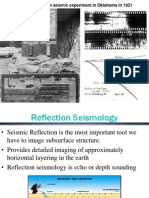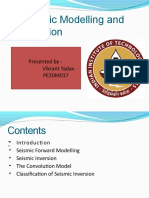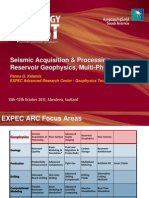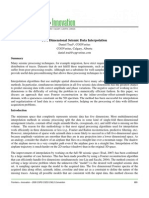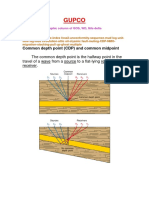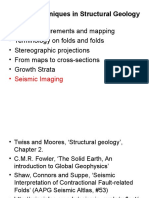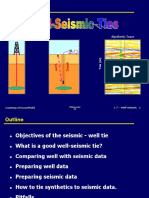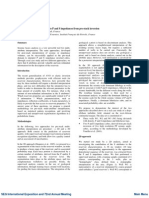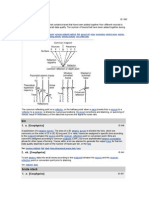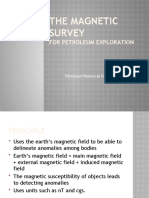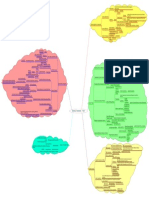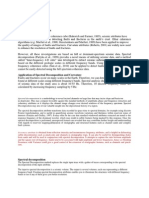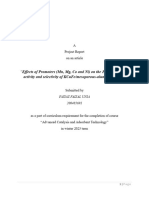0 ratings0% found this document useful (0 votes)
146 viewsIntroduction To Geophysics CHAPTER ONE
Introduction To Geophysics CHAPTER ONE
Uploaded by
Abraham SileshiThe document provides an overview of exploration geophysics as taught in a course at Adama Science and Technology University. It defines geophysics, discusses why it is important, and classifies geophysical methods. Exploration geophysics aims to discover subsurface resources using surface, borehole, and mining geophysical measurements and techniques. Key steps in geophysical data processing include digitization, signal analysis including Fourier analysis and spectrum analysis, and waveform processing methods like convolution, deconvolution, correlation, and digital filtering.
Copyright:
© All Rights Reserved
Available Formats
Download as PPTX, PDF, TXT or read online from Scribd
Introduction To Geophysics CHAPTER ONE
Introduction To Geophysics CHAPTER ONE
Uploaded by
Abraham Sileshi0 ratings0% found this document useful (0 votes)
146 views44 pagesThe document provides an overview of exploration geophysics as taught in a course at Adama Science and Technology University. It defines geophysics, discusses why it is important, and classifies geophysical methods. Exploration geophysics aims to discover subsurface resources using surface, borehole, and mining geophysical measurements and techniques. Key steps in geophysical data processing include digitization, signal analysis including Fourier analysis and spectrum analysis, and waveform processing methods like convolution, deconvolution, correlation, and digital filtering.
Original Description:
engineer daniel ture
Original Title
introduction to geophysics CHAPTER ONE
Copyright
© © All Rights Reserved
Available Formats
PPTX, PDF, TXT or read online from Scribd
Share this document
Did you find this document useful?
Is this content inappropriate?
The document provides an overview of exploration geophysics as taught in a course at Adama Science and Technology University. It defines geophysics, discusses why it is important, and classifies geophysical methods. Exploration geophysics aims to discover subsurface resources using surface, borehole, and mining geophysical measurements and techniques. Key steps in geophysical data processing include digitization, signal analysis including Fourier analysis and spectrum analysis, and waveform processing methods like convolution, deconvolution, correlation, and digital filtering.
Copyright:
© All Rights Reserved
Available Formats
Download as PPTX, PDF, TXT or read online from Scribd
Download as pptx, pdf, or txt
0 ratings0% found this document useful (0 votes)
146 views44 pagesIntroduction To Geophysics CHAPTER ONE
Introduction To Geophysics CHAPTER ONE
Uploaded by
Abraham SileshiThe document provides an overview of exploration geophysics as taught in a course at Adama Science and Technology University. It defines geophysics, discusses why it is important, and classifies geophysical methods. Exploration geophysics aims to discover subsurface resources using surface, borehole, and mining geophysical measurements and techniques. Key steps in geophysical data processing include digitization, signal analysis including Fourier analysis and spectrum analysis, and waveform processing methods like convolution, deconvolution, correlation, and digital filtering.
Copyright:
© All Rights Reserved
Available Formats
Download as PPTX, PDF, TXT or read online from Scribd
Download as pptx, pdf, or txt
You are on page 1of 44
Adama Science and Technology University
Faculty Of Applied Natural Science
Department of Applied Geology
Course Title: Exploration Geophysics (Geol 3322)
Lecturer: Abdela B. (MSc)
Chapter One : Introduction to Geophysics
Date: October 28, 2021
1.1 Definition
Geophysics belongs to the group of Earth Sciences, and it
integrates the knowledge primarily coming from geology,
mathematics and physics,
uses and develops physical measurement methods, mathematical
tools, data processing and analyzing techniques, as well as special
software packages to solve problems concerning the Earth’s interior
and surrounding space environment
Geophysical investigations of the interior of the Earth involve taking
measurements at or near the Earth’s surface that are influenced by
the internal distribution of physical properties.
Analysis of these measurements can reveal how the physical
properties of the Earth’s interior vary vertically and laterally
Geophysics as a field of science has played a major role in
increasing our knowledge of the earth's properties and physical
processes.
1.1 Definition
Why is geophysics important
Mapping large geological areas in order to increase
our knowledge of the Earth's structure
Locating and recovering resources namely;
hydrocarbons, minerals and groundwater
Mapping the uppermost meters of the Earth's crust
for tunnel construction
Assessing the risk of geohazards namely;
earthquakes, tsunamis and landslide
Archeological surveys
1.2 Classification of Geophysics Methods
The two scientific areas of geophysics (by the ranges
and objectives of the investigations):
1. Global Geophysics
2. Applied Geophysics
1.Global Geophysics:
It deals with large-scale problems and global
observations
Earth physics deals with the shape of the Earth, the
interior structure of it, plate tectonics
Gravity, seismology,magnetotellurics, and radiometric
dating are the most important disciplines
1.2 Classification of Geophysics Methods
2. Applied Geophysics:
Its main objective is to help in solving different practical
problems connecting to the subsurface by means of
geophysical measurements.
It tries to provide useful information for mining industry,
hydrological, environmental, geotechnical and archaeological
surveys.
The investigation depth is limited to the uppermost part of the
crust, which can reach a few 1000 metres below the surface
A special area of applied geophysics is the so-called near-
surface geophysics, which focuses on the investigation of
small-scale features in the shallow (tens of meters) subsurface.
1.2 Classification OF geophysical Methods
The applicability of all methods is based on the fact that the
variations of physical quantities measured as a function of space
(distance) and/or time (frequency and energy may also be the
reference quantity) are the consequence of changes in the
different material properties.
These changes are principally connected to the boundaries of
different rocks or rock-fluid systems.
1.3 Exploration Geophysics
Its primary objective is to discover subsurface
geological objects with which the deposits or
reservoirs of raw materials and energy sources may
associate under favourable conditions (e.g. ores,
coal, natural oil and gas, evaporites, and
geothermal energy).
It is also used for obtaining qualitative and
quantitative information about the targets of
interest, and the surrounding rock formations
1.3 Exploration Geophysics
Applied geophysics can be divided into further fields according to
the specialty of problems to be solved:
Exploration geophysics (this is the most significant field)
Hydrogeophysics:
Engineering geophysics: PR, R, S, M,EM
Environmental geophysics:
Archaeological geophysics: Magnetic, Resistivity GPR, EM
Forensic geophysics: S, E, M, EM methods search, the localization
and the mapping of buried objects or elements beneath the soil or
the water, using geophysics tools for legal purposes
1.3 Exploration Geophysics
1.3 Exploration Geophysics
Three branches of exploration or Applied
geophysics according to the site of measurements:
1.SurfaceGeophysics(airborne and marine geophysics)
2. Borehole Geophysics
3.Mining Geophysics
1.3.1 Surface Geophysics
Surface geophysical methods include magnetic,
gravity, seismic refraction, seismic reflection,
electrical resistivity, and, ground penetrating radar .
Major objectives of the surface geophysics:
Detecting the physical effects of the wanted
geological structures(Exploration perspective point
of view )
Determining the position and dimensions
(horizontal and vertical) of the indicated object
supporting the selection of drill sites in each phase
of the exploration.
1.3.2 Borehole Geophysics
The geologists and geophysicists carry out
borehole surveys using a wide range of intelligent
tool.
Borehole Geophysics methods include Natural
gamma ray, Spectral gamma ray, Porosity Logs and
Resistivity logging
We perform Borehole Geophysics in the areas of:
Reserve exploration and mining
Subsoil investigation
Hydrogeology, Geothermal energy
1.3.1 Borehole Geophysics
Main objectives of the borehole geophysics
1.Recording the different physical responses of the
formations traversed by the borehole,
2.determining some technical parameters of the
borehole,
3. performing the geological correlation among the
neighboring boreholes by comparing the measured
log curves
3.supporting the reinterpretation of results derived
from former geophysical measurements to create a
more precise and reliable model of the subsurface
1.4 Introduction to Geophysical Data Processing
Geophysical surveys measure the variation of some
physical quantity, with respect either to position or to
time
Data processing is a step between measuring geophysical
data and plotting it.
During this step, some errors in the measurements can be
corrected.
Geophysical signal analysis is concerned with the
detection and a subsequent processing of signals.
Any signal which is varying conveys valuable information.
Hence to understand the information embedded in such
signals, we need to 'detect' and 'extract data' from such
quantities.
1.4.1 Digitization of Geophysical Data
Digitization is the Procedure for transform analog
signals to digital data.
Analog and digital is the representation of the
Sinusoidal Function.
Digitization of Geophysical Data
The are two parameters of a digitizing system are the
sampling precision:
1.Dynamic range
2. Sampling frequency.
Dynamic range is an expression of the ratio of the largest
measurable amplitude to the smallest measurable
amplitude in a sampled function.
The unit is decibel and is defined as the ratio of two
power values and power is proportion to amplitude
Square
Digitization of Geophysical Data
In digital computers, digital samples are expressed
in binary form (they are composed of a sequence
of digits that have the value of either 0 or 1).
Each binary digit is known as a bit and the
sequence of bits representing the sample value is
known as a word.
The number of bits in each word determines the
dynamic range of a digitized waveform
Digitization of Geophysical Data
Sampling frequency is the number of sampling
points in unit time or unit distance.
Intuitively, it may appear that the digital sampling
of a continuous function inevitably leads to a loss
of information in the resultant digital function,
since the latter is only specified by discrete values
at a series of points
Digitization of Geophysical Data
Signal and Noise
Almost all signals contain noise
Signal to noise ratio is very important concept in
geophysics experiments.
Spectrum analysis
Spectrum analysis is a basic tool in signal
processing and shows how the signal power is
distributed as a function of spatial frequencies.
1.Fourier analysis
2. Sampling
3. Spectral time and frequency domain
Fourier analysis
Fourier analysis is the theory of the representation
of a function of a real variable by means of a series
of sines and cosines.
Fourier analysis
Fourier analysis
Fourier analysis
Fourier analysis
Waveform Processing
1. Convolution
2. De-convolution
3. Correlation
4. Digital Filtering
The principles of convolution, deconvolution and
correlation and digital Filtering form the common
basis for many methods of geophysical data
processing.
Convolution
It is the mathematical description of the change waveform shape after
pass through a filter(system).
There is special mathematical symbol for convolution (* ):
y(t) = g(t) * f(t), Where,
g(t): Impulse response function,
f(t) : input function (signal)
y(t) : the output function (signal)
Deconvolution
De-convoluation (Inverse filtering) is a inverse
operation to Convolution.
When is de-convoluation useful?
It is used to remove convolution distortion effect
and improve vertical resolution.
Correlation Functions
Correlation plays central role in the study of time
series
In general, correlation gives Quantitative estimate
of the degree similarity between two functions.
The Correlation functions of g and f both with N
samples is defined as:
Correlation Functions
Three type of correlation Functions;
1. Aut-correlation
2. Cross-correlation
3. Correlation Coefficient
Correlation Functions
Correlation Functions
Correlation Functions
Digital Filtering
Waveform as a combination of signal and noise.
The signal is that part of the waveform that relates
to the geological structures under investigation.
The noise is all other components of the waveform
The noise can be further subdivided into two
components: Random and Coherent noise
Digital filtering is employed in geophysical data
processing to improve SNR.
The two main types of digital filter: frequency
filters and inverse (de-convolution) filters
Frequency Filtering
Frequency filters discriminate against selected
frequency components of an input waveform and
may be low-pass (LP), high-pass (HP), band-pass
(BP) or band-reject(BR) in terms of their frequency
response.
Frequency filters are employed when the signal
and noise components of a waveform have
different frequency characteristics.
Low pass Filter
When a low-pass filter is applied only frequencies
below the cutoff frequency remain and the
frequencies above the cutoff frequency are
eliminated or attenuated.
Eliminate high frequencies:
Low pass filtering technique is often used to
remove noise, clean up signals, and perform data
averaging
High Pass Filter
When a high-pass filter is applied, signals below
the cutoff frequency are eliminated or attenuated
and signal above the cutoff frequency (pass band)
are kept.
High-pass filters technique is often used to clean
up low-frequency noise, and to highlight the high-
frequency trends.
Band pass Filter
Band pass filter is the difference between the
higher cut off frequency and the lower cut off
frequency.
Band-pass filter is considered as a second order
filter and it is usually used for noise cancelation.
Inverse (de-convolution) Filter
The main applications of inverse filtering to
remove the adverse effects of a previous filtering
operation lie in the field of seismic data processing.
Geophysical Modeling and Inversion
Geophysical Modeling and Inversion
Geophysical inversion refers to the mathematical
and statistical techniques for recovering
information on subsurface physical properties
from observed geophysical data.
Geophysical Modeling and Inversion
Geophysical Modeling and Inversion
You might also like
- Common Words in Oet Listening NotesDocument6 pagesCommon Words in Oet Listening NotesGeorge Andrews100% (1)
- Seismic SensorDocument1 pageSeismic SensorRogelio EsquedaNo ratings yet
- TCR Project GuideDocument66 pagesTCR Project GuideShraddha Harugade100% (3)
- Seismic Facies and Hydrocarbon Potential of Carbonate Reservoirs in Ramp SettingsDocument13 pagesSeismic Facies and Hydrocarbon Potential of Carbonate Reservoirs in Ramp SettingsRuth Santos NaranjoNo ratings yet
- First Reflection Seismic Experiment in Oklahoma in 1921Document59 pagesFirst Reflection Seismic Experiment in Oklahoma in 1921Ezzadin BabanNo ratings yet
- Post Stack 3d Seismic Fractures CharacterizationDocument5 pagesPost Stack 3d Seismic Fractures CharacterizationParvez ButtNo ratings yet
- Channel ElementsDocument16 pagesChannel ElementsMohamed Abd El-ma'boud100% (1)
- Basics of Seismic Wave TheoryDocument154 pagesBasics of Seismic Wave TheoryYinfeng Dong0% (1)
- Seismic ReflectionDocument21 pagesSeismic Reflectionvelkus2013No ratings yet
- Introduction To GeophysicsDocument7 pagesIntroduction To GeophysicsWubayehu DessalegnNo ratings yet
- 3-D Seismic Attributes: Dan Gr. Vetrici and Robert R. StewartDocument30 pages3-D Seismic Attributes: Dan Gr. Vetrici and Robert R. Stewartmichael2k7849100% (1)
- Pe20m017 Vikrantyadav Modelling and InversionDocument18 pagesPe20m017 Vikrantyadav Modelling and InversionNAGENDR_006No ratings yet
- Sonic PorosityDocument26 pagesSonic PorosityNagaraju JallaNo ratings yet
- Listric Normal FaultsDocument15 pagesListric Normal FaultsVaibhavSinghalNo ratings yet
- Use of Seismic Attributes For Sediment Classificat PDFDocument15 pagesUse of Seismic Attributes For Sediment Classificat PDFZarethNo ratings yet
- Seismic Acquisition & Processing Reservoir Geophysics, Multi-PhysicsDocument32 pagesSeismic Acquisition & Processing Reservoir Geophysics, Multi-PhysicsDjibril Idé AlphaNo ratings yet
- Seismic Reflection Surveying PDFDocument24 pagesSeismic Reflection Surveying PDFShawki BsatNo ratings yet
- Statics Correction ElevationDocument9 pagesStatics Correction ElevationAndi Mahri100% (2)
- Noise Attenuation Intmdt 03052018Document68 pagesNoise Attenuation Intmdt 03052018Pallav KumarNo ratings yet
- Lab 04 - Seismic DeconvolutionDocument10 pagesLab 04 - Seismic Deconvolutionapi-323770220No ratings yet
- Seismic Method in The ExplorationDocument3 pagesSeismic Method in The ExplorationRahmat Fadhilah100% (2)
- 5D InterpolationDocument4 pages5D InterpolationkadrawiNo ratings yet
- What Is Seismic Interpretation? Alistair BrownDocument4 pagesWhat Is Seismic Interpretation? Alistair BrownElisa Maria Araujo GonzalezNo ratings yet
- Gupco: Common Depth Point (CDP) and Common MidpointDocument3 pagesGupco: Common Depth Point (CDP) and Common MidpointmahmoudNo ratings yet
- II - Techniques in Structural Geology-SeismicDocument27 pagesII - Techniques in Structural Geology-SeismicAlionk GaaraNo ratings yet
- Residual Oil Saturation: The Information You Should Know About SeismicDocument9 pagesResidual Oil Saturation: The Information You Should Know About SeismicOnur AkturkNo ratings yet
- Basin Classification and Depositional Environments (Overview)Document2 pagesBasin Classification and Depositional Environments (Overview)Atubrah Prince100% (1)
- 3 CoherenceDocument28 pages3 CoherenceSagnik Basu RoyNo ratings yet
- Well Seismic Ties SDocument19 pagesWell Seismic Ties SDavid Karel AlfonsNo ratings yet
- Pertemuan Ke-1 - Introduction To Petroleum GeologyDocument29 pagesPertemuan Ke-1 - Introduction To Petroleum GeologycharlosmalinoNo ratings yet
- Seismic Facies Analysis and Structural Interpretation of The Sandakan Sub-Basin, Sulu Sea, PhilippinesDocument18 pagesSeismic Facies Analysis and Structural Interpretation of The Sandakan Sub-Basin, Sulu Sea, PhilippinesGatraNo ratings yet
- Seismic Facies Analysis Applied To P and S Impedances From Pre-Stack InversionDocument4 pagesSeismic Facies Analysis Applied To P and S Impedances From Pre-Stack InversionMahmoud EloribiNo ratings yet
- 2 - Volumetric Dip and AzimuthDocument20 pages2 - Volumetric Dip and AzimuthSagnik Basu RoyNo ratings yet
- VSP Vs SonicDocument16 pagesVSP Vs SonicAbdulaziz Al-asbaliNo ratings yet
- The Seismic ExperienceDocument96 pagesThe Seismic ExperienceIoana CorneliaNo ratings yet
- Dynamic CorrectionDocument18 pagesDynamic CorrectionMajid AliNo ratings yet
- Erth3021 Seismic Refraction PracDocument3 pagesErth3021 Seismic Refraction PracDhaffer Al-MezhanyNo ratings yet
- Statics: Seismic Data Processing ElnusaDocument24 pagesStatics: Seismic Data Processing ElnusaamrymokoNo ratings yet
- Exploration Techniques Geophysical Methods H. RueterDocument45 pagesExploration Techniques Geophysical Methods H. RueterBruno Pereyra QuirogaNo ratings yet
- HowTo Analyse AnglesDocument5 pagesHowTo Analyse Anglesbidyut_iitkgpNo ratings yet
- 09 Fluvial Deltaic Coastal EnvironmentDocument88 pages09 Fluvial Deltaic Coastal EnvironmentMas KulinNo ratings yet
- Depth Conversion of Post Stack Seismic Migrated Horizon Map MigrationDocument11 pagesDepth Conversion of Post Stack Seismic Migrated Horizon Map MigrationhimanshugstNo ratings yet
- N. (Geophysics) : Seismic Record Noise FoldDocument84 pagesN. (Geophysics) : Seismic Record Noise FoldRazi AbbasNo ratings yet
- Seismic SensorDocument16 pagesSeismic SensorNaveen Reddy100% (2)
- The Magnetic SurveyDocument15 pagesThe Magnetic Surveymelannie adanteNo ratings yet
- Seismic Imaging and Interpretation TechniquesDocument7 pagesSeismic Imaging and Interpretation Techniquesjoao kialaNo ratings yet
- Amplitude Versus OffsetDocument1 pageAmplitude Versus OffsetNguyen Truong SonNo ratings yet
- Interpretation of The Magnetic AnomaliesDocument24 pagesInterpretation of The Magnetic AnomaliesLambert StrongNo ratings yet
- The Integrated Approach To Seismic Attributes of Lithological Characterization of Reservoirs: Case of The F3 Block, North Sea-Dutch SectorDocument20 pagesThe Integrated Approach To Seismic Attributes of Lithological Characterization of Reservoirs: Case of The F3 Block, North Sea-Dutch Sectordjeddi mabroukNo ratings yet
- Seismicreflections ExxonDocument25 pagesSeismicreflections ExxonAamir LokhandwalaNo ratings yet
- BHSDocument67 pagesBHSEdward FrankyNo ratings yet
- Applied Sedimentology 4Document16 pagesApplied Sedimentology 4فؤاد ابوزيدNo ratings yet
- Geophysics - Lab4Document20 pagesGeophysics - Lab4David John MarcusNo ratings yet
- Seismic Inversion Mind MapDocument1 pageSeismic Inversion Mind MapAdel ShakerNo ratings yet
- Theory of Seismic Imaging PDFDocument226 pagesTheory of Seismic Imaging PDFAngel Saldaña100% (1)
- Why Spectral DecompositionDocument2 pagesWhy Spectral Decompositionanima1982No ratings yet
- Structural TasterDocument12 pagesStructural TasterAdri Muhammad RassalNo ratings yet
- Reservoir CharacterizationDocument5 pagesReservoir CharacterizationNGuyen Manh HungNo ratings yet
- Rivers and Floodplains: Forms, Processes, and Sedimentary RecordFrom EverandRivers and Floodplains: Forms, Processes, and Sedimentary RecordNo ratings yet
- Geology of Carbonate Reservoirs: The Identification, Description and Characterization of Hydrocarbon Reservoirs in Carbonate RocksFrom EverandGeology of Carbonate Reservoirs: The Identification, Description and Characterization of Hydrocarbon Reservoirs in Carbonate RocksNo ratings yet
- Atlas of Structural Geological Interpretation from Seismic ImagesFrom EverandAtlas of Structural Geological Interpretation from Seismic ImagesAchyuta Ayan MisraNo ratings yet
- Edited Multivariable CalculusDocument44 pagesEdited Multivariable CalculusAbraham SileshiNo ratings yet
- Geophysics Exploration - Chapter 6Document43 pagesGeophysics Exploration - Chapter 6Abraham SileshiNo ratings yet
- Ch-2, EarthquakesDocument56 pagesCh-2, EarthquakesAbraham SileshiNo ratings yet
- Network Mid ExamDocument2 pagesNetwork Mid ExamAbraham SileshiNo ratings yet
- Chapter 2 - Operating SystemsDocument12 pagesChapter 2 - Operating SystemsSai Vamsi GandhamNo ratings yet
- Complex Compound SentencesDocument19 pagesComplex Compound Sentencesapi-2973505870% (2)
- Swot Analysis FormDocument2 pagesSwot Analysis FormKhalid JavedNo ratings yet
- All About Air Quality PosterDocument1 pageAll About Air Quality PosterEstebanNo ratings yet
- The Digitalization of Steel Production : 21º Seminário de Automação e TIDocument12 pagesThe Digitalization of Steel Production : 21º Seminário de Automação e TISANTOSH KUMARNo ratings yet
- 56th Is Combat Rea Dy: She - e Answer Er eDocument2 pages56th Is Combat Rea Dy: She - e Answer Er eEd PalmerNo ratings yet
- Open Elective Minor Courses 2022-23-2023 24Document270 pagesOpen Elective Minor Courses 2022-23-2023 24parvezimad123No ratings yet
- 2da Invetigacion MineriaDocument9 pages2da Invetigacion MineriaEDITH CONSTANZA PEA CUEVASNo ratings yet
- Overwatch ExcerptDocument19 pagesOverwatch ExcerptI Read YANo ratings yet
- Battling Fatigue in Aviation - Recent Advancements in Research and PracticeDocument12 pagesBattling Fatigue in Aviation - Recent Advancements in Research and PracticeHasan ArslanNo ratings yet
- Differential Diagnosis Pain Right HypochondriumDocument35 pagesDifferential Diagnosis Pain Right HypochondriumDrArish Mahmood100% (1)
- Loads and Loading Combinations For CE157 StudentsDocument48 pagesLoads and Loading Combinations For CE157 Studentsemss100% (1)
- Maternal and Fetal Assessment During LaborDocument66 pagesMaternal and Fetal Assessment During LaborHazelynne Mamucud100% (2)
- TFS Assets - MSD - Brochures - BR53223 Spectronic 200 Spectrophotometer BrochureDocument8 pagesTFS Assets - MSD - Brochures - BR53223 Spectronic 200 Spectrophotometer BrochureJose L TrejoNo ratings yet
- Class A, B, AB, C AmplifiersDocument24 pagesClass A, B, AB, C AmplifierstikiraNo ratings yet
- Erik PrasetyoDocument136 pagesErik PrasetyoNabhan PuteraNo ratings yet
- Çikmiş Sorular: TensesDocument23 pagesÇikmiş Sorular: TensesleventNo ratings yet
- Examen 2Document12 pagesExamen 2Emily HurtadoNo ratings yet
- ASTMB936Document4 pagesASTMB936eng.usmanali2012No ratings yet
- BalangigaDocument1 pageBalangigaPdrrmo Eastern SamarNo ratings yet
- Literature Review On African Swine FeverDocument8 pagesLiterature Review On African Swine Feverea2pbjqk100% (1)
- Pes Cavus: Eka Anggraini Padma Vidya GayatriDocument13 pagesPes Cavus: Eka Anggraini Padma Vidya GayatriPadma VidyaNo ratings yet
- DIALISIS Fresenius 2008KDocument64 pagesDIALISIS Fresenius 2008KJose M SNo ratings yet
- Insert Plate DesignDocument8 pagesInsert Plate Designvrajan1988No ratings yet
- The Identification of Turquoise by Infrared Spectroscopy and X Ray Powder DiffractionDocument5 pagesThe Identification of Turquoise by Infrared Spectroscopy and X Ray Powder Diffraction8duke8No ratings yet
- ENPC 880AA Major Project Report - 200485691Document60 pagesENPC 880AA Major Project Report - 200485691FaiyazNo ratings yet
- Lista de Filtros Da PanteraDocument26 pagesLista de Filtros Da PanterajessicaNo ratings yet
- Geology Geophysics in Oil ExplorationDocument70 pagesGeology Geophysics in Oil Explorationberbere68100% (1)




